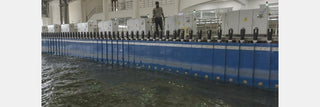Introduction
The Indian Institute of Technology Madras (IIT Madras) has recently unveiled Asia's largest Shallow Wave Basin Research Facility at its Thaiyur campus. This state-of-the-art infrastructure is a significant milestone in India's advancements in coastal and marine engineering.
Facility Overview
The Shallow Wave Basin Research Facility is designed to address critical challenges in ports, waterways, and coastal research. Located at the ‘Discovery’ Satellite Campus, about 36 km from IIT Madras, the facility features a multi-directional shallow wave basin capable of analyzing complex wave-current interactions.
Indigenous Development
Most of the Shallow Wave Basin was developed as part of the ‘Make in India’ initiative. Except for a few imported components, the design, architecture, and fabrication were carried out in-house, ensuring long-term sustainability and efficiency of the facility.
Applications and Impact
The basin has vast applications, from testing the effects of 3D waves on structures to aiding in harbor, offshore, coastal, and inland waterways projects. It allows studies on sediment transport, wave impact loading, and structural stability in the face of climate change.
Collaboration and Global Significance
Professor Torsten Schlurmann of Leibniz University Hannover, a collaborator and expert in wave-current research, emphasized the facility’s global significance. He stated that it would enhance IIT Madras’s stature as a leading institution in marine science and engineering.
Future Prospects
The facility will not only aid in planning for India’s coastal and inland waterways development but also support other institutes like IITs and NITs in establishing similar advanced research infrastructures. This new facility marks a significant milestone in the pursuit of knowledge and innovation.
Conclusion
IIT Madras's launch of Asia's largest Shallow Wave Basin Research Facility showcases India's growing technical and research prowess in coastal and marine engineering. This facility is a testament to the strides made in promoting technological innovation and addressing critical challenges in marine and coastal engineering.

















